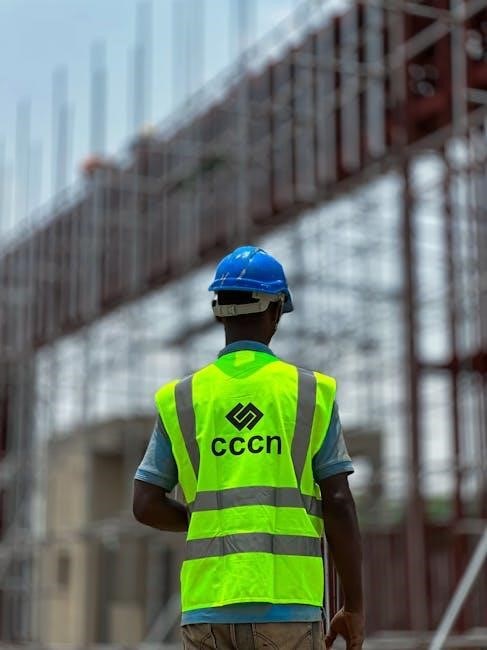Construction estimating is the process of calculating all required costs for a project, ensuring accurate budgeting and planning. It involves detailed cost analysis for materials, labor, and equipment, helping contractors and stakeholders understand financial expectations. Accurate estimates are crucial for project success, enabling effective planning, execution, and profitability while meeting client expectations.
1.1 What is Construction Estimating?
Construction estimating is the process of calculating the total cost of a construction project. It involves analyzing materials, labor, and equipment costs to provide an accurate financial overview. This process ensures projects are completed within budget and on time. Estimators use project plans, specifications, and historical data to determine costs. The goal is to deliver a detailed, realistic estimate that helps contractors secure contracts and clients trust. Accurate estimating is vital for project success and long-term business sustainability.
1.2 Importance of Accurate Estimating in Construction
Accurate construction estimating is crucial for ensuring projects are completed within budget and on time. It helps contractors secure contracts by presenting realistic bids and builds trust with clients. Proper cost analysis reduces financial risks and avoids overruns. Accurate estimates also enable better resource allocation, ensuring materials and labor are used efficiently. This precision fosters long-term profitability and business sustainability, while meeting client expectations and maintaining a competitive edge in the industry.
1.3 Brief Overview of the Estimating Process
The estimating process involves gathering project details, analyzing risks, and quantifying materials, labor, and equipment costs. It begins with reviewing plans and specifications to understand scope and requirements. Estimators then calculate direct costs, such as materials and labor, and incorporate indirect costs like overheads and insurance. Profit margins and contingencies are added to finalize the bid. The process ensures a comprehensive and accurate estimate, enabling informed decision-making and successful project execution while aligning with client expectations and budget constraints.

Key Components of a Construction Estimate
A construction estimate includes direct costs (materials, labor, equipment), indirect costs (overheads, permits, insurance), and additional factors like profit margins and contingency funds for unpredicted expenses.
2.1 Direct Costs (Materials, Labor, Equipment)
Direct costs are expenses directly tied to project execution, such as materials, labor, and equipment. Materials include all necessary supplies, while labor costs cover wages for workers. Equipment expenses encompass rental or ownership costs of machinery. These costs are typically quantifiable and vary based on project scope and duration. Accurate estimation of direct costs is essential for budgeting and ensuring profitability, as they form the bulk of a project’s expenses.
2.2 Indirect Costs (Overheads, Permits, Insurance)
Indirect costs are expenses not directly tied to construction tasks but essential for project management. Overheads include office expenses and administrative fees. Permits and licenses ensure legal compliance, while insurance covers risks like liability and worker injuries. These costs are allocated across projects and are crucial for accurate budgeting, as they add to the overall financial burden without being tied to specific tasks. Proper estimation of indirect costs ensures comprehensive project planning and avoids cost overruns.
2.3 Profit Margins and Contingency Funds
Profit margins are added to estimates to ensure a company’s financial sustainability and desired earnings. Contingency funds, on the other hand, are reserves allocated for unforeseen expenses or risks. Both are essential for maintaining project viability and ensuring financial stability. Profit margins vary based on market conditions and company goals, while contingency funds are typically calculated as a percentage of total costs. Accurate inclusion of these elements ensures projects remain profitable and adaptable to unexpected challenges, safeguarding both contractors and clients from financial setbacks. Proper allocation enhances overall project resilience and success.

The Estimating Process: Step-by-Step
The estimating process involves gathering project details, analyzing risks, quantifying materials, estimating labor and equipment costs, incorporating overheads, and finalizing the estimate with thorough review.
3.1 Gathering Project Information (Plans, Specifications, Contracts)
Gathering project information is the foundation of accurate estimating. This step involves collecting and reviewing plans, specifications, and contracts to understand the project’s scope and requirements. Plans provide a visual representation of the work, while specifications detail materials, methods, and standards. Contracts outline the legal and financial obligations, including timelines and payment terms. Additional documents, such as RFIs (Requests for Information), may also be reviewed to clarify uncertainties. Thoroughly analyzing these documents ensures the estimate aligns with the project’s expectations and reduces potential errors.
3.2 Analyzing Risk and Uncertainties
Analyzing risk and uncertainties is critical in construction estimating to identify potential issues that could impact the project. This involves assessing factors like material price volatility, labor shortages, and unforeseen site conditions. By evaluating historical data and project specifics, estimators can anticipate risks and incorporate contingency plans. Mitigation strategies, such as value engineering or alternative materials, can help reduce uncertainties. Accurate risk analysis ensures the estimate remains realistic and adaptable, safeguarding the project from unexpected costs or delays while maintaining profitability and stakeholder confidence.
3.3 Quantifying Material Requirements
Quantifying material requirements involves determining the exact quantities of materials needed for the project. This step requires a detailed review of project plans, specifications, and contracts. Estimators use tools like takeoff software to measure quantities from blueprints and calculate material needs. Accuracy is crucial to avoid overestimating or underestimating costs. Factors such as waste, shrinkage, and potential delays are also considered. By breaking down materials into specific categories (e.g., lumber, concrete, steel), estimators ensure precise cost allocation, enabling a realistic and actionable budget for the project.
3.4 Estimating Labor Costs
Estimating labor costs involves calculating the total wages, benefits, and overhead for workers. This is done by determining the number of workers needed, their hourly rates, and the total hours required for each task. Labor costs are often calculated using historical data and productivity rates. Factors such as project complexity, location, and potential overtime must be considered. Accurate labor cost estimation ensures realistic budgeting and helps in allocating resources effectively. It also accounts for training, safety, and potential workforce fluctuations, ensuring a comprehensive labor cost breakdown.
3.5 Calculating Equipment Costs
Equipment costs are calculated by considering rental, ownership, or leasing expenses. This includes purchasing, maintenance, fuel, and operator wages. Historical data and manufacturer guidelines help estimate hourly or daily rates. Factors like project duration, equipment idle time, and transportation costs are also considered. Accurate equipment cost calculation ensures budget accuracy and project profitability. Additionally, understanding whether to rent or buy equipment based on usage frequency is crucial for optimizing costs. Detailed cost breakdowns help in creating realistic project estimates and avoiding financial overruns.
3.6 Incorporating Overheads and Profit Margins
Overheads and profit margins are essential components of a construction estimate. Overheads cover indirect costs like office expenses, insurance, and permits, typically calculated as a percentage of direct costs. Profit margins are added to ensure the contractor’s profitability, varying based on project complexity and market conditions. These additions ensure the estimate is comprehensive, covering all expenses and desired profits, while remaining competitive and financially sustainable for the contractor. Accurate inclusion of these ensures the project’s viability and long-term business success.
3.7 Finalizing the Estimate and Review
Finalizing the estimate involves a thorough review to ensure accuracy and completeness. This step confirms that all costs, including materials, labor, equipment, and overheads, are correctly calculated and aligned with the project scope. A detailed review helps identify potential errors or oversights, ensuring the estimate meets client expectations and project requirements. Once validated, the estimate is presented as a professional document, ready for submission or further negotiation.
Advanced Estimating Techniques
Advanced techniques enhance accuracy by leveraging historical data, value engineering, and technology. These methods optimize cost calculations, improve precision, and streamline the estimating process for better project outcomes.
4.1 Using Historical Data for Benchmarking
Historical data provides valuable insights for benchmarking in construction estimating. By analyzing past project costs, estimators can identify trends, measure performance, and refine future estimates. This approach ensures consistency and accuracy, allowing for better budgeting and resource allocation. Historical data helps in establishing reliable cost baselines, reducing uncertainties, and improving overall project planning. It also enables estimators to track cost fluctuations and adjust estimates accordingly, enhancing the reliability of financial projections. This method is essential for maintaining project profitability and client satisfaction.
4.2 Implementing Value Engineering
Value engineering optimizes project value by analyzing functions and costs, ensuring maximum efficiency. It identifies opportunities to reduce expenses without compromising performance or safety. By evaluating alternative materials, methods, and designs, estimators can enhance cost-effectiveness. This approach fosters innovation, improving resource allocation and client satisfaction. Value engineering is a proactive strategy to deliver high-quality results within budget, making it a cornerstone of successful construction estimating. Its implementation ensures that projects meet both functional and financial objectives effectively.
4.3 Leveraging Technology for Accuracy
Technology plays a pivotal role in enhancing the accuracy of construction estimates. Advanced software tools, such as Building Information Modeling (BIM) and estimating platforms, streamline data analysis and reduce errors. These tools enable real-time collaboration, automated calculations, and detailed cost tracking. By integrating historical data and current market trends, technology ensures estimates are precise and up-to-date. Additionally, digital solutions facilitate better project management, allowing adjustments to be made efficiently. Leveraging technology not only improves accuracy but also accelerates the estimating process, enabling teams to deliver reliable and competitive bids.
4.4 Conducting a Bid Analysis
Conducting a bid analysis involves a detailed evaluation of subcontractor and supplier bids to ensure accuracy and alignment with project requirements. This process includes organizing and comparing bids, verifying cost breakdowns, and assessing assumptions made by bidders. It also involves identifying potential risks and discrepancies. A thorough bid analysis is critical for cost management, ensuring that the selected bids align with the project’s budget and scope. This step is essential for making informed decisions and achieving a balanced and competitive final estimate.

Common Challenges in Construction Estimating
Construction estimating faces challenges like volatile material prices, unclear project details, and tight deadlines. These factors can lead to inaccuracies, cost overruns, and miscommunication with stakeholders.
5.1 Managing Cost Volatility (Material Prices, Labor Rates)
Material prices and labor rates often fluctuate due to market demand, supply chain disruptions, or economic changes. These fluctuations can significantly impact project budgets, making accurate estimating challenging. Estimators must stay informed about current pricing trends and adjust estimates accordingly. Strategies include incorporating contingency funds, negotiating fixed-price contracts, and leveraging historical data for benchmarks. Regularly updating cost databases and collaborating with suppliers can also help mitigate volatility. Accurate forecasting and real-time adjustments are essential to maintain profitability and avoid cost overruns.
5.2 Dealing with Unclear or Incomplete Project Details
Unclear or incomplete project details can lead to inaccurate estimates and potential cost overruns. Estimators must rely on incomplete plans or specifications, which can result in delays or rework. To address this, estimators should request additional details from clients or architects and use historical data as a reference. Including contingency funds and collaborating with stakeholders can help manage uncertainties. Clear communication and documentation of assumptions are essential to avoid misunderstandings and ensure alignment with project goals. Regular updates and adjustments are necessary as more information becomes available.
5.3 Time Constraints and Tight Deadlines
Tight deadlines can significantly impact the accuracy of construction estimates, as estimators may rush through critical steps. Time constraints often lead to incomplete data collection, insufficient review, and overlooked details, increasing the risk of errors. To manage this, estimators must prioritize tasks, focus on high-impact cost items, and leverage technology for efficiency. Clear communication with stakeholders is essential to negotiate realistic timelines and ensure alignment with project goals. Balancing speed and precision is crucial to delivering reliable estimates under time pressure.
5.4 Communicating with Stakeholders Effectively
Effective communication with stakeholders is critical for successful construction estimating. Clear and concise exchanges ensure all parties understand the scope, costs, and potential risks. Regular updates and transparent discussions help manage expectations and build trust. Miscommunication can lead to disputes or project delays, so it’s essential to maintain open lines of dialogue. Using accessible language and providing detailed documentation fosters collaboration and alignment. Regular meetings and written updates are key to ensuring everyone remains informed and aligned throughout the estimating and planning process.

Tools and Software for Construction Estimating
Advanced tools like Bluebeam, PlanGrid, and BIM enhance accuracy and efficiency in construction estimating. These platforms streamline material takeoffs, automate calculations, and integrate real-time data for precise cost analysis.
6.1 Popular Estimating Software (e.g., Bluebeam, PlanGrid)
Bluebeam and PlanGrid are leading software tools in construction estimating, offering advanced features for precise cost calculations. Bluebeam provides robust markup and collaboration tools, enabling seamless teamwork and accurate quantity takeoffs. PlanGrid excels in managing project documents and automating material tracking, ensuring all costs are accounted for. These platforms integrate with BIM models, enhancing efficiency and reducing errors. By leveraging these tools, estimators can produce detailed, reliable estimates that align with project specifications and client expectations, ultimately driving successful project outcomes and profitability.
6.2 Utilizing BIM for Enhanced Accuracy
Building Information Modeling (BIM) revolutionizes construction estimating by providing detailed 3D models that enhance accuracy. BIM enables precise quantity takeoffs, automating material calculations and reducing manual errors. It integrates all project data, allowing real-time collaboration and ensuring estimates align with design specifications. By visualizing the project, BIM identifies potential issues early, minimizing cost overruns. This technology streamlines the estimating process, improving efficiency and delivering reliable results, making it a cornerstone of modern construction estimating practices for precise and efficient project planning.
6.3 Spreadsheets vs. Specialized Estimating Tools
Spreadsheets are traditional tools for construction estimating, offering flexibility and simplicity for small projects. However, they require manual calculations, increasing the risk of errors. Specialized estimating tools, like Bluebeam or PlanGrid, automate processes, enhance accuracy, and integrate with other software. They provide real-time updates, collaboration features, and advanced reporting, making them ideal for complex projects. While spreadsheets are cost-effective, specialized tools offer scalability and efficiency, ensuring precise and efficient cost management in modern construction projects, ultimately improving overall project outcomes and team productivity.
Best Practices for Effective Estimating
Maintain detailed records, regularly update cost databases, and collaborate with project teams to ensure accuracy. Document assumptions and clarify uncertainties for transparent and reliable estimates.
7.1 Maintaining Detailed and Organized Records
Maintaining detailed and organized records is essential for effective construction estimating; This involves documenting all cost-related data, including material prices, labor rates, and equipment expenses. By keeping records organized, estimators can quickly access historical data, ensuring accuracy and consistency in future estimates. Additionally, organized records help in identifying cost trends and potential savings, which can be crucial for competitive bidding. Regular audits and updates to these records further enhance their reliability and relevance to current projects. Proper documentation also aids in disputes and provides a clear audit trail for stakeholders.
7.2 Regularly Updating Cost Databases
Regularly updating cost databases is critical for accurate construction estimating. Material prices, labor rates, and equipment costs fluctuate, and outdated data can lead to inaccurate bids. Estimators should use industry reports, supplier updates, and historical project data to keep databases current. This ensures estimates reflect market conditions and remain competitive. Regular updates also help identify cost trends, enabling better budgeting and decision-making. By staying informed about price changes, estimators can deliver more precise and reliable cost projections, ultimately enhancing project profitability and stakeholder confidence.
7.3 Collaborating with Project Teams
Collaborating with project teams is essential for effective construction estimating. Estimators must work closely with architects, engineers, and contractors to share knowledge and refine estimates. Open communication ensures alignment on project scope, materials, and timelines. This teamwork helps identify potential cost-saving opportunities and reduces uncertainties. By involving all stakeholders early, estimators can incorporate diverse perspectives, improving accuracy and ensuring comprehensive bids. Regular meetings and transparent discussions foster a collaborative environment, ultimately leading to more realistic and achievable project budgets while building trust among team members and clients.
7.4 Documenting Assumptions and Clarifications
Documenting assumptions and clarifications is critical for transparency and accountability in construction estimating. Clearly outlining the basis of estimates, such as material costs or labor rates, ensures all stakeholders understand the foundation of the bid. This practice minimizes misunderstandings and potential disputes. Regularly reviewing and updating documented assumptions as project details evolve helps maintain accuracy. By keeping detailed records, estimators can justify their calculations and demonstrate thoroughness, fostering trust with clients and project teams while ensuring alignment with project goals and expectations throughout the construction process.
Avoiding Common Mistakes in Estimating
Avoiding common mistakes in estimating requires careful attention to detail, accurate data, and clear communication. Overlooking hidden costs, ignoring risks, or using outdated pricing can lead to significant errors. Ensuring transparency and double-checking assumptions helps prevent these pitfalls, fostering trust and project success while maintaining profitability and stakeholder satisfaction throughout the construction process.
8.1 Overlooking Hidden Costs
Overlooking hidden costs is a common mistake in construction estimating that can lead to budget overruns and project delays. Hidden costs may include permits, inspections, and unexpected repairs. These expenses are often not immediately apparent but can significantly impact the overall budget. Failing to account for such costs can result in financial strain and credibility loss. To avoid this, estimators must conduct thorough site analyses and incorporate contingency funds. Regular reviews and detailed documentation help ensure all potential expenses are considered, preventing costly surprises during execution.
8.2 Ignoring Potential Risks
Ignoring potential risks in construction estimating can lead to significant delays and cost overruns. Failing to identify and account for risks such as material shortages, weather conditions, or design flaws can result in unforeseen expenses. Additionally, overlooking regulatory changes or site-specific challenges can exacerbate these issues. Estimators must conduct thorough risk assessments and incorporate contingency plans to mitigate these uncertainties. Proactively addressing potential risks ensures better project control and reduces the likelihood of budget overruns, ultimately enhancing project success and stakeholder confidence.
8.3 Using Outdated Pricing Information
Using outdated pricing information in construction estimating can lead to inaccurate cost projections, resulting in potential losses. Material and labor costs often fluctuate due to market dynamics, inflation, or supply chain disruptions. Relying on old data may underestimate or overestimate expenses, causing budget misalignments. Regularly updating cost databases and referencing current market rates ensures estimates remain realistic and competitive. Failing to do so can lead to cost overruns or loss of contracts, emphasizing the importance of timely data refreshes in maintaining estimate accuracy and project viability.
8.4 Poor Communication with Clients
Poor communication with clients can lead to misunderstandings, unmet expectations, and project delays. Failing to clearly explain the estimate, including assumptions and inclusions, can result in disputes over costs or scope. Miscommunication may also lead to unrealistic client expectations, causing dissatisfaction. Regular, transparent communication ensures alignment on project goals, timelines, and budgets, fostering trust and collaboration. Effective communication is essential for resolving issues promptly and maintaining a positive client relationship throughout the project lifecycle.
Presenting and Negotiating the Estimate
Presentation involves clearly communicating the estimate to clients, ensuring transparency and understanding. Negotiation focuses on aligning expectations, addressing concerns, and finalizing terms to achieve mutual agreement and project success.
9.1 Preparing a Clear and Concise Proposal
A well-structured proposal is essential for winning projects. It should include a detailed scope of work, itemized costs, timelines, and payment terms. Clarity ensures clients understand the value and scope, while conciseness keeps the document focused. Use professional formatting and avoid jargon to enhance readability. Highlight unique selling points and demonstrate how the project meets their needs. Including visuals like charts or graphs can make the proposal more engaging and easier to understand. Regularly update cost databases to ensure accuracy and relevance in the proposal.
9.2 Understanding Client Expectations
Understanding client expectations is crucial for delivering a successful project. Effective communication ensures alignment with their vision, budget, and timeline. Actively listen to their needs, ask clarifying questions, and confirm understanding through detailed documentation. Regular updates and transparent discussions help manage evolving expectations. Addressing ambiguities early prevents costly changes later. By aligning estimates with client priorities, you build trust and ensure the final product meets their goals. Tailoring your approach to their specific requirements enhances satisfaction and fosters long-term relationships.
9.3 Negotiation Strategies
Negotiation strategies in construction estimating involve clear communication and understanding of both parties’ objectives. Active listening and empathy help align expectations while maintaining professionalism. Flexibility is key, as it allows for creative solutions that satisfy all stakeholders. Presenting options with clear trade-offs enables informed decisions. Transparency in costs and risks builds trust. Leverage data and historical benchmarks to support your position. Emphasize value proposition and long-term benefits to reach a mutually beneficial agreement. Successful negotiations ensure project feasibility and foster strong client relationships, driving successful outcomes.

Continuous Improvement in Estimating
Continuous improvement in construction estimating involves post-project reviews, feedback collection, and adapting to industry trends. Regularly analyzing past estimates enhances accuracy and efficiency, ensuring better future outcomes.
10.1 Conducting Post-Project Reviews
Post-project reviews are essential for identifying successes and areas for improvement in construction estimating. By comparing initial estimates with actual costs, teams can pinpoint discrepancies and understand root causes. Documenting lessons learned ensures transparency and accountability, while implementing feedback leads to refined processes. This practice fosters a culture of continuous learning, enhancing the accuracy of future estimates and driving long-term project success and organizational growth.
10.2 Gathering Feedback from Clients and Teams
Gathering feedback from clients and teams is crucial for refining construction estimating processes. Client feedback helps ensure estimates align with expectations, while team input identifies internal efficiencies and areas for improvement. Regular communication and structured feedback loops foster collaboration and transparency. By actively listening to stakeholders, estimators can address concerns, refine cost databases, and enhance future project accuracy. This collaborative approach strengthens relationships and ensures continuous improvement in delivering accurate and client-focused estimates.
10.3 Staying Updated with Industry Trends
Staying updated with industry trends ensures estimators remain competitive and informed. Advances in technology, such as BIM and AI, enhance accuracy and efficiency. Monitoring market fluctuations in material costs and labor rates helps adjust estimates accordingly. Engaging in training, attending webinars, and participating in industry forums provide insights into best practices. By staying informed, estimators can adopt innovative tools and methodologies, maintain compliance with standards, and deliver estimates aligned with current industry developments, ensuring projects remain feasible and cost-effective in a dynamic environment.
